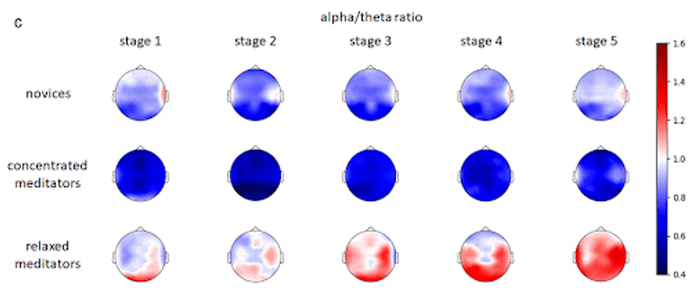A study from researchers at the HSE Centre for Bioelectric Interfaces reveals differences in brain activity and other body systems during meditation. Their results, for the first time, demonstrate that while under the same instructions, some people relax and others concentrate.
The practice of meditation has grown in popularity with western cultures in past years, sparking an increase in studies focused on understanding the impacts that meditation has on the human brain and body. Research has shown that meditating regularly has a positive effect on an individual’s psychological state, reduces stress and systemic inflammation, and can slow the development of age-related cognitive disorders.
The increased popularity of meditation has also prompted the development of tools that promise to boost the effectiveness of meditation by analyzing the physiological indicators of the mediator and providing them with biofeedback. But, scientists do not yet understand meditation and its processes, or how it impacts the individual.
In their study, researchers gathered two groups (28 people): one group of regular meditators for at least two years (for an average of eight years), and another group with no meditation experience. These participants all underwent the same 37 minute meditation with the same instructions (developed specifically for the study). Researchers observed the participants and gathered information about the changes meditation prompts in human psychological indicators.
“It was important that we planned the experiment in a way that linked the registered physiological indicators to specific parts of the meditation,” says Maria Volodina, first author and Junior Research Fellow at the HSE Centre for Bioelectric Interfaces, in a statement. “The majority of existing studies just compare meditation and resting state, but they do not analyze how physiological indicators change during immersion into and out of the meditative state.”

To make assisted meditation possible, researchers said, it was necessary to understand the goals an individual had for their practice including the state they wished to achieve and the path that could be used to ‘guide’ them to that state. Researchers worked to solve the problem by consulting with experienced meditation instructors to modify and divide instructions into separate parts. This allowed participants to receive a brief instruction and then perform it during a pause.
To observe the effects on the brain and body, researchers recorded EEG, heart rate, respiratory rate, and galvanic skin response. This made it possible for them to understand how the process of entering and exiting a meditative state changed the data points they had collected.
Researchers anticipated that experienced meditators would experience changes in their physiological indicators that suggested a relaxed state of mental concentration and body relaxation, but the results were not consistent with their hypothesis. Rather, the experienced meditators were split down the middle, with half experiencing changes in brain activity such as a decrease in alpha rhythm indicating concentration and the other half showing slowed breathing and increased heart rate variability consistent with relaxation.
In the concentrated group, these changes were most apparent in the middle of meditation and had returned to base levels by the end. The relaxed group experienced gently increasing levels of relaxation throughout the meditation and continuing after its end. The control group without meditation experience fell in the middle of the two experienced groups, displaying no significant changes in indicators of either body relaxation or mental concentration.
“We have several hypotheses that could explain the results. We have already started the necessary experiments to test them. One possible explanation is that every person has an innate predisposition to one or another physiological strategy of immersion in the meditative state,” says Volodina. “If this hypothesis is true, the use of standardized devices for teaching meditation based on biofeedback may not only be ineffective in achieving the desired result, but could actually be harmful to some users. The question of whether one of the strategies may be preferable for the long-term positive effects of meditation still needs to be studied.”
This study was published in PLOS ONE journal.
Article by Anna Landry







-392x250.jpg)




Comments